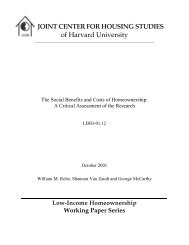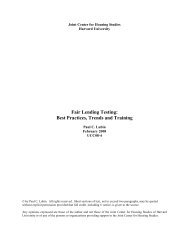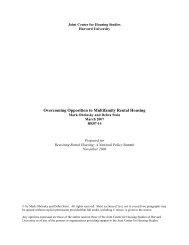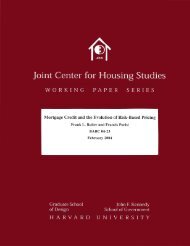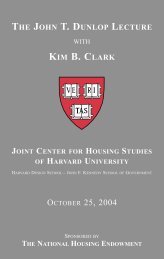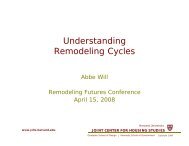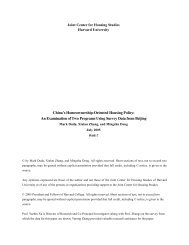please do not cite or circulate without permission of the authors
please do not cite or circulate without permission of the authors
please do not cite or circulate without permission of the authors
You also want an ePaper? Increase the reach of your titles
YUMPU automatically turns print PDFs into web optimized ePapers that Google loves.
after completion, <strong>the</strong> gap shrinks by an average <strong>of</strong> 5.6 percentage points to only 4.8<br />
percent lower than <strong>the</strong> price <strong>of</strong> a comparable property in <strong>the</strong> community district.<br />
As this picture also shows, however, <strong>the</strong> average price differential between <strong>the</strong><br />
rings and <strong>the</strong>ir community districts was already declining pri<strong>or</strong> to project completion.<br />
Even <strong>without</strong> <strong>the</strong> homeownership development, perhaps, it might have continued to<br />
decline. On <strong>the</strong> o<strong>the</strong>r hand, some <strong>of</strong> <strong>the</strong> decline that occurred pri<strong>or</strong> to project completion<br />
might in fact have been due to <strong>the</strong> construction <strong>or</strong> announcement <strong>of</strong> <strong>the</strong> new owneroccupied<br />
homes.<br />
Figure 9: Selected Coefficients from Regression Results with Ring-Specific, Time-Trend<br />
Dependent Variable = Log <strong>of</strong> Price Per Unit<br />
Model 1 Model 2 Model 3<br />
Ring500 -0.195<br />
(0.019)<br />
Ring1000 -0.158<br />
(0.012)<br />
Ring2000 -0.125<br />
(0.009)<br />
PostRing500 0.039<br />
(0.012)<br />
PostRing1000 0.019<br />
(0.008)<br />
PostRing2000 0.017<br />
(0.005)<br />
TPost500 -0.008<br />
(0.002)<br />
TPost1000 -0.005<br />
(0.001)<br />
TPost2000 -0.001<br />
(0.001)<br />
Adjusted R-squared 0.801 0.802 0.804<br />
N 300,890 300,890 300,890<br />
Note: All regressions include ring-specific time trends, modeled as a five-segment linear spline. See<br />
Appendix B f<strong>or</strong> full results, including time spline. Standard err<strong>or</strong>s in paren<strong>the</strong>ses.<br />
Thus, as mentioned above, this specification <strong>do</strong>es <strong>not</strong> provide a clear summary<br />
measure <strong>of</strong> impact. To arrive at such a measure, we estimate an alternative specification<br />
that <strong>of</strong>fers an estimate <strong>of</strong> impact above and beyond what would have been predicted<br />
given pri<strong>or</strong> trends in prices in <strong>the</strong> ring. To control f<strong>or</strong> <strong>the</strong>se trends, <strong>the</strong>se specifications<br />
model time f<strong>or</strong> <strong>the</strong> ring properties as a linear spline with five segments (see equations 5<br />
23



